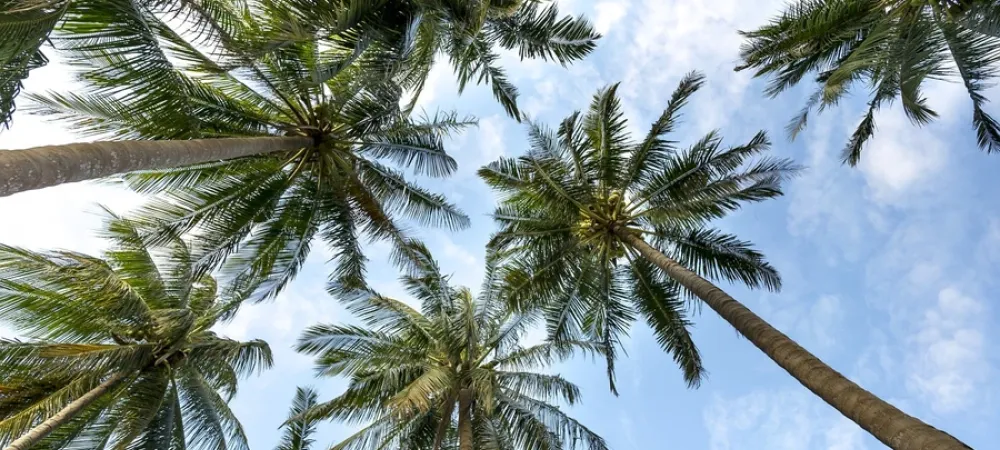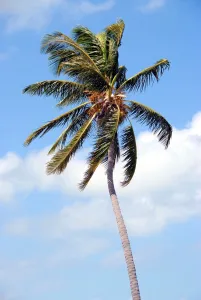Types of Palm Trees in Southwest Florida

Palm trees are a defining feature of Southwest Florida's landscape, creating a tropical paradise for residents and visitors alike. While there are many different types of palm trees in the area, here are the most common types and information about how to keep them healthy.
The Different Types of Palm Trees in SWFL
Southwest Florida is home to a wide variety of palm trees that thrive in the region’s warm, tropical climate. Here are some of the most common types:
The Coconut Palm
One of the most iconic palms in Southwest Florida is the Coconut Palm (Cocos nucifera). Known for its slender trunk, feather-like fronds, and clusters of coconuts, this tree is synonymous with tropical beach scenes. Coconut Palms are not only ornamental but also functional, as they produce edible coconuts that can be used in cooking, for hydration, and even in skincare products.

These palms thrive in warm, coastal areas, making Southwest Florida an ideal home. They can grow up to 80 feet tall, providing shade and an undeniable sense of relaxation wherever they’re planted. Coconut Palms require regular maintenance to prevent falling coconuts, which can pose a hazard. Key identifiers of this type of palm tree include:
- Smooth, grayish-brown trunk that is often slightly curved or leaning.
- Long, arching fronds with narrow, pointed leaflets.
- Can grow up to 80 feet or more.
- Visible rings along the trunk where old fronds were attached.
- The upper part of the trunk (below the fronds) is usually green and smooth.
The Cabbage Palm
The Cabbage Palm (Sabal palmetto), also known as the Sabal Palm, is the state tree of Florida. Its fan-shaped leaves and rugged trunk make it a staple in landscapes across the region. Unlike the Coconut Palm, the Cabbage Palm does not produce large fruit, but its heart (often called the "cabbage") is edible and can be used in various dishes.
This hardy palm can grow up to 65 feet tall and is extremely adaptable to different soil types, from salty coastal areas to more inland locations. It’s a low-maintenance tree that can tolerate hurricanes and drought conditions, making it a popular choice for both residential and public landscaping. Key identifiers of this type of palm tree include:
- Large, stiff, blade-like leaf segments form a rounded "fan."
- The trunk is often covered with fibrous material, revealing a smoother trunk as it matures.
- The canopy is dense, with tightly clustered fronds.
- Can grow up to 65 feet or more.
- Produces mall, white flowers and black, pea-sized berries.
The Foxtail Palm
The Foxtail Palm (Wodyetia bifurcata) is a favorite among homeowners and landscapers because of its distinct, full fronds that resemble the bushy tail of a fox. Native to Australia, the Foxtail Palm has quickly become one of the most sought-after palms in Florida due to its beauty and adaptability.
This palm can reach heights of 30 feet and grows relatively quickly compared to other palms. It thrives in full sun and well-drained soil, making it a great option for both commercial and residential settings. The tree’s vibrant green fronds and smooth, gray trunk add a touch of elegance to any landscape. Key identifiers of this type of palm tree include:
- Fronds are full and arching, resembling a bushy fox's tail, with numerous narrow leaflets.
- Grows up to 30 feet tall.
- Produces clusters of small, round, bright red fruits.
- The trunk is smooth and light gray, often with visible rings where old fronds have fallen off.
- The fronds form a dense, spherical canopy.
The Royal Palm
The Royal Palm (Roystonea regia) is often considered the most majestic of all palms, as the name suggests. These towering trees, which can grow up to 100 feet tall, are often seen lining streets, parks, and large estates in Southwest Florida. With their smooth, light gray trunks and long, arching fronds, Royal Palms add a grand, stately presence to any landscape.

While they are incredibly eye-catching, Royal Palms require specific care to thrive. They prefer well-drained soils and a steady supply of nutrients, often requiring fertilization. Despite their need for attention, their beauty and grace make them a cherished feature in many Southwest Florida landscapes. Key identifiers of this type of palm tree include:
- A tall, smooth, light gray to white trunk, often slightly swollen at the base.
- Long, arching, feather-shaped fronds that create a graceful, flowing canopy.
- Produces green fruit that ripens to a reddish-black color.
- Can grow up to 100 feet or more
- A smooth, green section just below the fronds, where the trunk meets the canopy.
Small Types of Palm Trees
In addition to the towering varieties, there are several smaller palms that add beauty to gardens and smaller spaces that thrive in Southwest Florida:
Pygmy Date Palm
The Pygmy Date Palm (Phoenix roebelenii) is a miniature version of the larger date palms. Growing to about 10 feet tall, this palm is perfect for smaller landscapes or as a focal point in gardens. It’s often used as an accent plant due to its attractive, arching fronds and compact size. Despite its small stature, the Pygmy Date Palm adds a lush, tropical feel to any setting.
Florida Thatch Palm
The Florida Thatch Palm (Thrinax radiata) is a slower-growing palm that reaches heights of about 20 feet. Its thin trunk and fan-shaped leaves make it a great choice for coastal areas and smaller gardens. Native to Florida, this palm is highly tolerant of salty soils and sea breezes, making it a perfect fit for beachside properties.
Areca Palm
The Areca Palm (Dypsis lutescens), often used as a hedge or privacy screen, is a clumping palm with multiple trunks and feathery fronds. It can grow up to 20 feet tall, but its dense foliage and rapid growth make it ideal for creating natural barriers in residential landscapes. Arecas are low-maintenance palms that thrive in partial shade and well-drained soil, making them popular in both indoor and outdoor spaces.
Preventing Palm Tree Diseases
While palm trees are a beautiful and integral part of Southwest Florida’s scenery, they are also susceptible to certain diseases. Proper care and maintenance can help prevent common issues such as:
- Lethal Bronzing Disease (LBD): This bacterial disease has been affecting palms across Florida, causing yellowing fronds and eventually killing the tree. Early detection and removal of infected trees can help stop its spread.
- Ganoderma Butt Rot: A fungal infection that attacks the base of the palm, causing it to weaken and eventually fall. There is no cure for this disease, so prevention through proper irrigation and soil care is key.
- Nutrient Deficiencies: Palms often suffer from a lack of essential nutrients like magnesium and potassium, leading to yellowing leaves and stunted growth. Regular fertilization with a palm-specific formula can help maintain their health.
By staying vigilant and caring for your palms with the right nutrients and preventive measures, you can enjoy their beauty for years to come. If you need professional tree care for your SWFL home, call Tony's! Our team offers palm tree protection that will help you maintain your beautiful landscape. Contact us today for a free quote.
